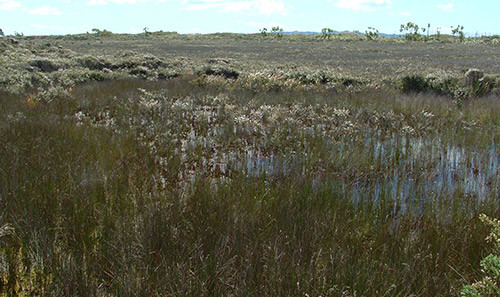Wetland rules
Wetlands are crucial to our environment. They filter out contaminants like sediment and E.coli, and they support a greater concentration of wildlife than any other habitat in New Zealand.
There are strict rules regulating the types of activities that are allowed in and around wetlands:
- Resource Management (National Environmental Standards for Freshwater) Regulations 2020, clauses 37 to 56
- Regional Plan for Northland, section C.2.2 Activities affecting wetlands and section C.5.1 Taking and use of water
In most cases NES for Freshwater has stricter rules for wetlands than the Regional Plan.
This page provides a summary of these rules.
If you have any questions about the identification of a wetland on your land, or are unsure which rules apply, please get in touch with us.
What is a wetland?
The term 'wetland' covers habitats where the land is covered in, or saturated by water for at least some of the time.
Wetlands occur in areas where surface water collects or where underground water seeps through to the surface. There are many kinds of wetland, including swamps, bogs, marshes, gumlands, saltmarshes, mangroves and some river, lake and stream edges.
For more information about why wetlands are important check out: www.nrc.govt.nz/wetlands
The Resource Management Act (RMA) defines wetlands as:
"... permanently or intermittently wet areas, shallow water, and land water margins that support a natural ecosystem of plants and animals that are adapted to wet conditions”
The rules in the NES for Freshwater and Regional Plan apply to “natural wetlands”. They have slightly different definitions, but basically a natural wetland is a wetland (as defined in the RMA) but excludes:
(a) wetland constructed by artificial means (but not if it used to be a natural wetland or it was constructed to offset impacts on another natural wetland)
(b) wet paddocks
This is a summary of the definitions – it would pay to check the actual definitions if you’re unsure.
We have mapped some wetlands in Northland - but this is far from complete.
 Peat Bog, Karikari Peninsula.
Peat Bog, Karikari Peninsula.
Wetland or wet paddock?
The definition of natural wetland in the Regional Plan for Northland excludes:
- wet pasture, damp gully heads
- areas where water temporarily ponds after rain
- pasture containing patches of rushes
The NES for Freshwater definition excludes:
any area of improved pasture that, at the commencement date, is dominated by (that is more than 50% of) exotic pasture species and is subject to temporary rain-derived water pooling
improved pasture means an area of land where exotic pasture species have been deliberately sown or maintained for the purpose of pasture production, and species composition and growth has been modified and is being managed for livestock grazing.
In simple terms, if it looks like a paddock with some scattered / isolated rushes in it but the majority is exotic pasture plants, then it probably isn’t a wetland. However, discrete areas of the paddock may still qualify, in particular wet areas adjoining or in close proximity to water bodies. In many cases a simple vegetation survey could be used to identify whether the 50% exotic pasture species exemption applies but defining the extent of a wetland ‘on the ground’ can be complex - if in doubt, it is recommended that expert advice is sought.
Wetland rules
This section is a summary of the rules in the NES for Freshwater. There are also rules in the Regional Plan that also apply but the NES for Freshwater rules are stricter and;
The NES for Freshwater (Regulation 54) requires resource consent be obtained for:
- Vegetation clearance within, or within 10m of, a natural wetland
- Earthworks or land disturbance within, or within 10m of, a natural wetland
- Earthworks within a 100m of a wetland if it might result in any drainage of a natural wetland
- The taking, use, damming, diversion, or discharge of water within, or within 100 m of, a wetland. For example, the diversion of water from buildings, drains, driveways, or earthworks - even if ‘downstream’ of the wetland.
There are some exceptions, which are permitted activities:
- Wetland restoration (Regulation 38, NES for Freshwater)
- Scientific research (Regulation 40, NES for Freshwater)
- Maintenance of wetland utility structures (Regulation 43, NES for Freshwater)
- Maintenance and operation of specified infrastructure and other infrastructure (Regulation 46, NES for Freshwater)
- Arable and horticultural land use (Regulation 50, NES for Freshwater)
- Natural hazard works (Regulation 51, NES for Freshwater)
- Discharges of wastewater to land (because it is a discharge to land)
- Water takes allowed under section 14(3)(b) RMA.
If you think your activity meets one of these exceptions, then check the relevant regulation to make sure you can meet all the conditions. You should also check the Regional Plan because while many of these activities are permitted, there are circumstances where a resource consent will be needed under the Regional Plan.
Any activity in a natural wetland that results in any drainage of it is a prohibited activity (Regulation 53) if it is not specifically provided for by a regulation in the NES for Freshwater. An example is digging a drain in a natural wetland.
